Developers
Client SDKs
AMP
AMP SDK
Android
Initialization
Configuration
Network Security Configuration
Event Tracking
User Attributes
IDSync
Screen Events
Commerce Events
Location Tracking
Media
Kits
Application State and Session Management
Data Privacy Controls
Error Tracking
Opt Out
Push Notifications
WebView Integration
Logger
Preventing Blocked HTTP Traffic with CNAME
Workspace Switching
Linting Data Plans
Troubleshooting the Android SDK
API Reference
Upgrade to Version 5
Cordova
Cordova Plugin
Identity
Direct Url Routing
Direct URL Routing FAQ
Web
Android
iOS
iOS
Workspace Switching
Initialization
Configuration
Event Tracking
User Attributes
IDSync
Screen Tracking
Commerce Events
Location Tracking
Media
Kits
Application State and Session Management
Data Privacy Controls
Error Tracking
Opt Out
Push Notifications
Webview Integration
Upload Frequency
App Extensions
Preventing Blocked HTTP Traffic with CNAME
Linting Data Plans
Troubleshooting iOS SDK
Social Networks
iOS 14 Guide
iOS 15 FAQ
iOS 16 FAQ
iOS 17 FAQ
iOS 18 FAQ
API Reference
Upgrade to Version 7
React Native
Getting Started
Identity
Unity
Upload Frequency
Getting Started
Opt Out
Initialize the SDK
Event Tracking
Commerce Tracking
Error Tracking
Screen Tracking
Identity
Location Tracking
Session Management
Xamarin
Getting Started
Identity
Web
Initialization
Configuration
Content Security Policy
Event Tracking
User Attributes
IDSync
Page View Tracking
Commerce Events
Location Tracking
Media
Kits
Application State and Session Management
Data Privacy Controls
Error Tracking
Opt Out
Custom Logger
Persistence
Native Web Views
Self-Hosting
Multiple Instances
Web SDK via Google Tag Manager
Preventing Blocked HTTP Traffic with CNAME
Facebook Instant Articles
Troubleshooting the Web SDK
Browser Compatibility
Linting Data Plans
API Reference
Upgrade to Version 2 of the SDK
Alexa
API References
Data Subject Request API
Data Subject Request API Version 1 and 2
Data Subject Request API Version 3
Platform API
Key Management
Platform API Overview
Accounts
Apps
Audiences
Calculated Attributes
Data Points
Feeds
Field Transformations
Services
Users
Workspaces
Warehouse Sync API
Warehouse Sync API Overview
Warehouse Sync API Tutorial
Warehouse Sync API Reference
Data Mapping
Warehouse Sync SQL Reference
Warehouse Sync Troubleshooting Guide
ComposeID
Warehouse Sync API v2 Migration
Calculated Attributes Seeding API
Bulk Profile Deletion API Reference
Data Planning API
Group Identity API Reference
Custom Access Roles API
Pixel Service
Profile API
Audit Logs API
Events API
mParticle JSON Schema Reference
IDSync
Quickstart
Android
Overview
Step 1. Create an input
Step 2. Verify your input
Step 3. Set up your output
Step 4. Create a connection
Step 5. Verify your connection
Step 6. Track events
Step 7. Track user data
Step 8. Create a data plan
Step 9. Test your local app
iOS Quick Start
Overview
Step 1. Create an input
Step 2. Verify your input
Step 3. Set up your output
Step 4. Create a connection
Step 5. Verify your connection
Step 6. Track events
Step 7. Track user data
Step 8. Create a data plan
Python Quick Start
Step 1. Create an input
Step 2. Create an output
Step 3. Verify output
Server SDKs
Node SDK
Go SDK
Python SDK
Ruby SDK
Java SDK
Guides
Partners
Introduction
Outbound Integrations
Outbound Integrations
Firehose Java SDK
Inbound Integrations
Compose ID
Glossary
Migrate from Segment to mParticle
Migrate from Segment to mParticle
Migrate from Segment to Client-side mParticle
Migrate from Segment to Server-side mParticle
Segment-to-mParticle Migration Reference
Data Hosting Locations
Rules Developer Guide
API Credential Management
The Developer's Guided Journey to mParticle
Guides
Composable Audiences
Composable Audiences Overview
User Guide
User Guide Overview
Warehouse Setup
Warehouse Setup Overview
Audience Setup
Frequently Asked Questions
Customer 360
Overview
User Profiles
Overview
User Profiles
Group Identity
Overview
Create and Manage Group Definitions
Calculated Attributes
Calculated Attributes Overview
Using Calculated Attributes
Create with AI Assistance
Calculated Attributes Reference
Getting Started
Create an Input
Start capturing data
Connect an Event Output
Create an Audience
Connect an Audience Output
Transform and Enhance Your Data
Platform Guide
Billing
Usage and Billing Report
The New mParticle Experience
The new mParticle Experience
The Overview Map
Observability
Observability Overview
Observability User Guide
Observability Troubleshooting Examples
Observability Span Glossary
Platform Settings
Audit Logs
Key Management
Platform Configuration
Event Match Quality Dashboard (Early Access)
Event Forwarding
Notifications
System Alerts
Trends
Introduction
Data Retention
Data Catalog
Connections
Activity
Data Plans
Live Stream
Filters
Rules
Blocked Data Backfill Guide
Tiered Events
mParticle Users and Roles
Analytics Free Trial
Troubleshooting mParticle
Usage metering for value-based pricing (VBP)
IDSync
IDSync Overview
Use Cases for IDSync
Components of IDSync
Store and Organize User Data
Identify Users
Default IDSync Configuration
Profile Conversion Strategy
Profile Link Strategy
Profile Isolation Strategy
Best Match Strategy
Aliasing
Segmentation
Audiences
Audiences Overview
Create an Audience
Connect an Audience
Manage Audiences
Audience Sharing
Match Boost
FAQ
Classic Audiences
Standard Audiences (Legacy)
Predictive Audiences
Predictive Audiences Overview
Using Predictive Audiences
New vs. Classic Experience Comparison
Analytics
Introduction
Core Analytics (Beta)
Setup
Sync and Activate Analytics User Segments in mParticle
User Segment Activation
Welcome Page Announcements
Settings
Project Settings
Roles and Teammates
Organization Settings
Global Project Filters
Portfolio Analytics
Analytics Data Manager
Analytics Data Manager Overview
Events
Event Properties
User Properties
Revenue Mapping
Export Data
UTM Guide
Analyses
Analyses Introduction
Segmentation: Basics
Getting Started
Visualization Options
For Clauses
Date Range and Time Settings
Calculator
Numerical Settings
Segmentation: Advanced
Assisted Analysis
Properties Explorer
Frequency in Segmentation
Trends in Segmentation
Did [not] Perform Clauses
Cumulative vs. Non-Cumulative Analysis in Segmentation
Total Count of vs. Users Who Performed
Save Your Segmentation Analysis
Export Results in Segmentation
Explore Users from Segmentation
Funnels: Basics
Getting Started with Funnels
Group By Settings
Conversion Window
Tracking Properties
Date Range and Time Settings
Visualization Options
Interpreting a Funnel Analysis
Funnels: Advanced
Group By
Filters
Conversion over Time
Conversion Order
Trends
Funnel Direction
Multi-path Funnels
Analyze as Cohort from Funnel
Save a Funnel Analysis
Explore Users from a Funnel
Export Results from a Funnel
Saved Analyses
Manage Analyses in Dashboards
Query Builder
Data Dictionary
Query Builder Overview
Modify Filters With And/Or Clauses
Query-time Sampling
Query Notes
Filter Where Clauses
Event vs. User Properties
Group By Clauses
Annotations
Cross-tool Compatibility
Apply All for Filter Where Clauses
Date Range and Time Settings Overview
User Attributes at Event Time
Understanding the Screen View Event
User Aliasing
Dashboards
Dashboards––Getting Started
Manage Dashboards
Dashboard Filters
Organize Dashboards
Scheduled Reports
Favorites
Time and Interval Settings in Dashboards
Query Notes in Dashboards
Analytics Resources
The Demo Environment
Keyboard Shortcuts
User Segments
Data Privacy Controls
Data Subject Requests
Default Service Limits
Feeds
Cross-Account Audience Sharing
Import Data with CSV Files
Import Data with CSV Files
CSV File Reference
Glossary
Video Index
Analytics (Deprecated)
Identity Providers
Single Sign-On (SSO)
Setup Examples
Introduction
Developer Docs
Introduction
Integrations
Introduction
Rudderstack
Google Tag Manager
Segment
Data Warehouses and Data Lakes
Advanced Data Warehouse Settings
AWS Kinesis (Snowplow)
AWS Redshift (Define Your Own Schema)
AWS S3 Integration (Define Your Own Schema)
AWS S3 (Snowplow Schema)
BigQuery (Snowplow Schema)
BigQuery Firebase Schema
BigQuery (Define Your Own Schema)
GCP BigQuery Export
Snowflake (Snowplow Schema)
Snowplow Schema Overview
Snowflake (Define Your Own Schema)
Developer Basics
Aliasing
Integrations
ABTasty
Audience
24i
Event
Aarki
Audience
Actable
Feed
AdChemix
Event
Adobe Marketing Cloud
Cookie Sync
Server-to-Server Events
Platform SDK Events
Adobe Audience Manager
Audience
Adobe Campaign Manager
Audience
AdMedia
Audience
Adobe Experience Platform
Event
Adobe Target
Audience
AdPredictive
Feed
AgilOne
Event
Algolia
Event
Amazon Kinesis
Event
Amazon Advertising
Audience
Amazon S3
Event
Amazon Redshift
Data Warehouse
Amazon SNS
Event
Amazon SQS
Event
Amobee
Audience
Anodot
Event
Antavo
Feed
Apptentive
Event
Apptimize
Event
Awin
Event
Apteligent
Event
Microsoft Azure Blob Storage
Event
Bing Ads
Event
Bidease
Audience
Bluecore
Event
Bluedot
Feed
Branch S2S Event
Event
Bugsnag
Event
Census
Feed
Cadent
Audience
comScore
Event
Conversant
Event
Custom Feed
Custom Feed
Crossing Minds
Event
Databricks
Data Warehouse
Datadog
Event
Didomi
Event
Eagle Eye
Audience
Emarsys
Audience
Edge226
Audience
Epsilon
Event
Everflow
Audience
Facebook Offline Conversions
Event
Flurry
Event
Google Analytics for Firebase
Event
Flybits
Event
FreeWheel Data Suite
Audience
ForeSee
Event
Friendbuy
Event
Google Ad Manager
Audience
Google Analytics
Event
Google Analytics 4
Event
Google BigQuery
Audience
Data Warehouse
Google Enhanced Conversions
Event
Google Marketing Platform
Audience
Cookie Sync
Event
Google Pub/Sub
Event
Google Marketing Platform Offline Conversions
Event
Google Tag Manager
Event
Herow
Feed
Hightouch
Feed
Ibotta
Event
ID5
Kit
Heap
Event
Hyperlocology
Event
Impact
Event
InMarket
Audience
Inspectlet
Event
Intercom
Event
ironSource
Audience
Kafka
Event
Kissmetrics
Event
LaunchDarkly
Feed
Kubit
Event
LifeStreet
Audience
LiveLike
Event
Liveramp
Audience
Localytics
Event
mAdme Technologies
Event
MadHive
Audience
Marigold
Audience
Microsoft Azure Event Hubs
Event
Mediasmart
Audience
Microsoft Ads
Microsoft Ads Audience Integration
MediaMath
Audience
Mintegral
Audience
Monetate
Event
Movable Ink
Event
Movable Ink - V2
Event
Multiplied
Event
Nami ML
Feed
Nanigans
Event
NCR Aloha
Event
OneTrust
Event
Neura
Event
Oracle BlueKai
Event
Paytronix
Feed
Personify XP
Event
Persona.ly
Audience
Plarin
Event
Primer
Event
Quantcast
Event
Qualtrics
Event
Rakuten
Event
Regal
Event
Reveal Mobile
Event
RevenueCat
Feed
Salesforce Mobile Push
Event
Scalarr
Event
SimpleReach
Event
Shopify
Custom Pixel
Feed
Singular-DEPRECATED
Event
Skyhook
Event
Smadex
Audience
SmarterHQ
Event
Slack
Event
Snapchat Conversions
Event
Snowflake
Data Warehouse
Snowplow
Event
Splunk MINT
Event
StartApp
Audience
Talon.One
Event
Audience
Feed
Loyalty Feed
Tapad
Audience
Tapjoy
Audience
Taptica
Audience
Taplytics
Event
The Trade Desk
Cookie Sync
Audience
Event
Teak
Audience
Ticketure
Feed
Triton Digital
Audience
TUNE
Event
Valid
Event
Vkontakte
Audience
Vungle
Audience
Webhook
Event
Webtrends
Event
Wootric
Event
Yotpo
Feed
White Label Loyalty
Event
Xandr
Cookie Sync
Audience
YouAppi
Audience
Yahoo (formerly Verizon Media)
Audience
Cookie Sync
The Overview Map
The Overview Map provides an interactive diagram of your mParticle data infrastructure, including all of your data inputs, outputs, and configured mParticle features.
How to access the Overview Map
The Overview Map is the first page you see after logging into your account at app.mparticle.com.
You can navigate back to the Overview Map at any time by clicking the Overview button in the left hand nav bar.
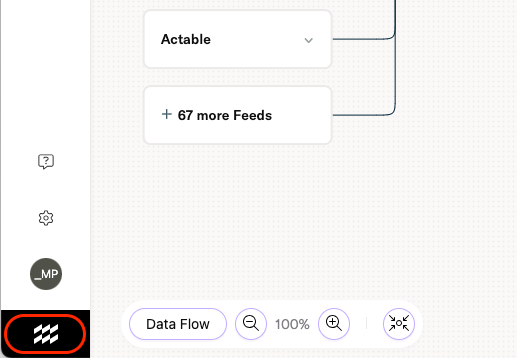
The Overview Map is unique to each workspace in your account, because each workspace may contain a different configuration of inputs, outputs, and mParticle features. If you can’t find an input, output, or feature that you are expecting to see on the Overview Map, make sure you have selected the correct workspace.
Overview Map settings
The Overview Map has a few basic settings allowing you to control its appearance, and the type of information it displays.
Zoom
You can zoom your view of the Overview Map in and out by clicking the + or - magnifying glass icons in the bottom left corner of the map.

Switching views
The Overview Map provides two different views. Each view is designed to highlight a different collection of information describing your mParticle account.
You can switch between different views of the Overview Map using the View button to the left of the zoom controls.
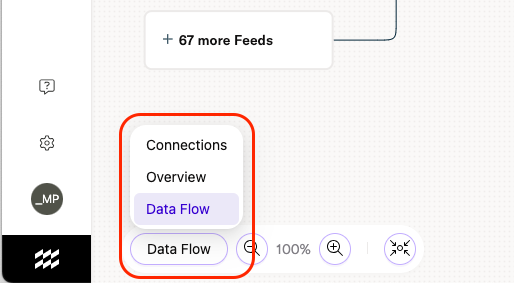
Overview
The Data Flow view provides a complete diagram of each specific feature your data flows through between your inputs and outputs, including Rules, Data Plans, and Filters.
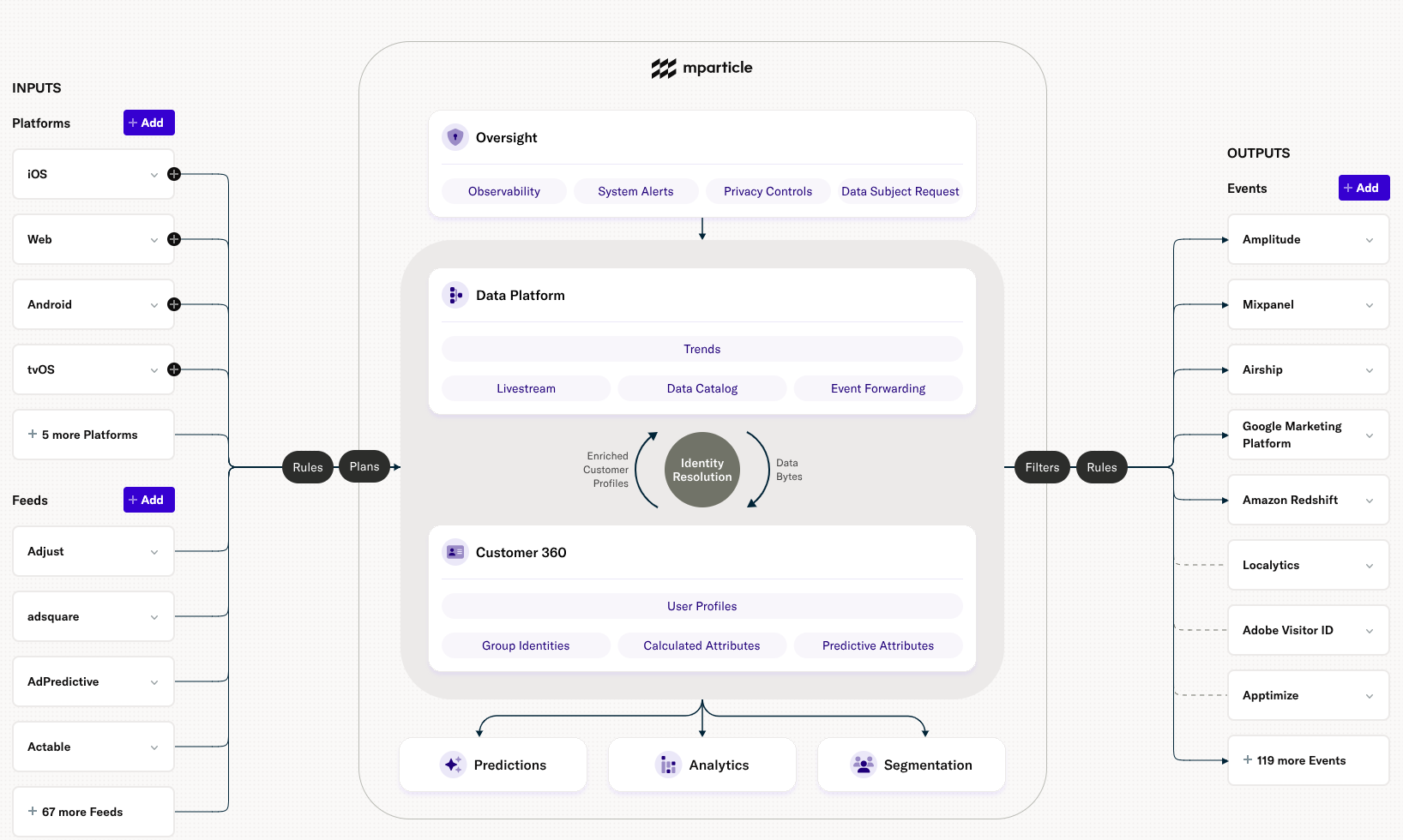
Connections view
The Connections view only displays your inputs, outputs, and the connections between them.
To see which inputs and outputs are connected, hover your cursor over any input or output, and a highlighted purple line will appear showing the connections. Every output connected to a single input will be highlighted. For example, in the map below you can see that the iOS input is connected to the Amplitude and Amazon Redshift outputs, in addition to a selection of other outputs.
If your workspace contains a large number of inputs or outputs, you can view them in a complete list by clicking the + more Events button.

Navigating with the Overview Map
The Overview Map is interactive: you can use it to navigate to different products, features, and settings within mParticle.
If you see a product or feature shown on the map that you can’t click on, your role doesn’t have adequate permissions to view it. Contact your mParticle account administrator to request access.
Inputs
Your inputs are the sources of your customer data. You can create Platform inputs, which use the mParticle SDKs to collect and ingest data directly from different device platforms (like iOS or Web), or Feed inputs, which ingest data from third-party marketing or data warehouse tools.
All of your inputs are listed on the left side of the Overview Map, with the Platform and Feed inputs separated into two groups.
Add an input
To add an input, click the + Add button next to Platforms or Feeds under INPUTS to create an input of either type.
This opens the Setup > Inputs page, where you can create a new Platform or Feed input.
See connections
To view connections between an input and your outputs, hover your cursor over an input’s card and a highlighted purple line will appear between the input and any connected outputs.
Add a connection
To add a connection from an input, click the + icon next to an input card.
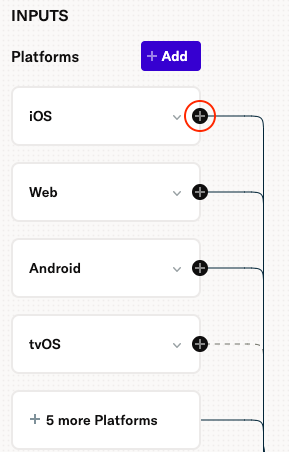
This opens the Connections > Connect page for that particular platform input, where you can select one of your configured outputs to connect the input to.
Outputs
Outputs are the destinations of your customer data. These are third-party marketing, analytics, or data warehouse tools that can accept either event data or user data.
Your outputs are shown on the right side of the Overview Map.
Add an output
To add an output, click the + Add button next to Events under OUTPUTS to create an Events output.
This opens the Setup > Outputs page where you can select one of the many available output integrations to configure.
See connected inputs
To see which inputs are connected to an output, hover your cursor over an output’s card and a highlighted purple line will appear between the output and any connected inputs.
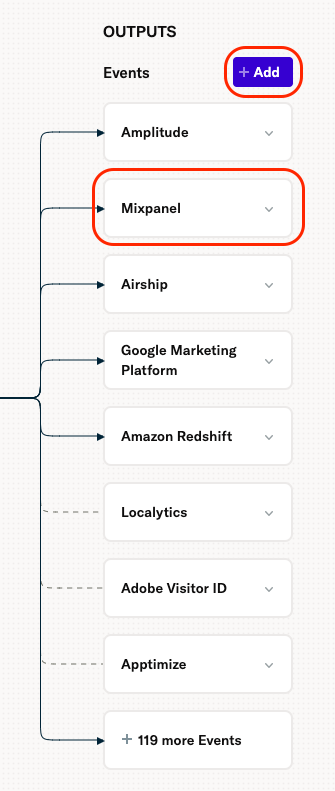
View output configurations
A single output can have multiple configurations. To see an expanded list of configurations for an output, click the output’s card.
By hovering your cursor over each card in the expanded list, you can see which inputs send data to that particular configuration.
mParticle Suites
The mParticle platform includes several suites, or collections, of tools that you use to monitor, manage, and leverage your customer data. There are six different suites, and they are are displayed in the center of the Overview Map:
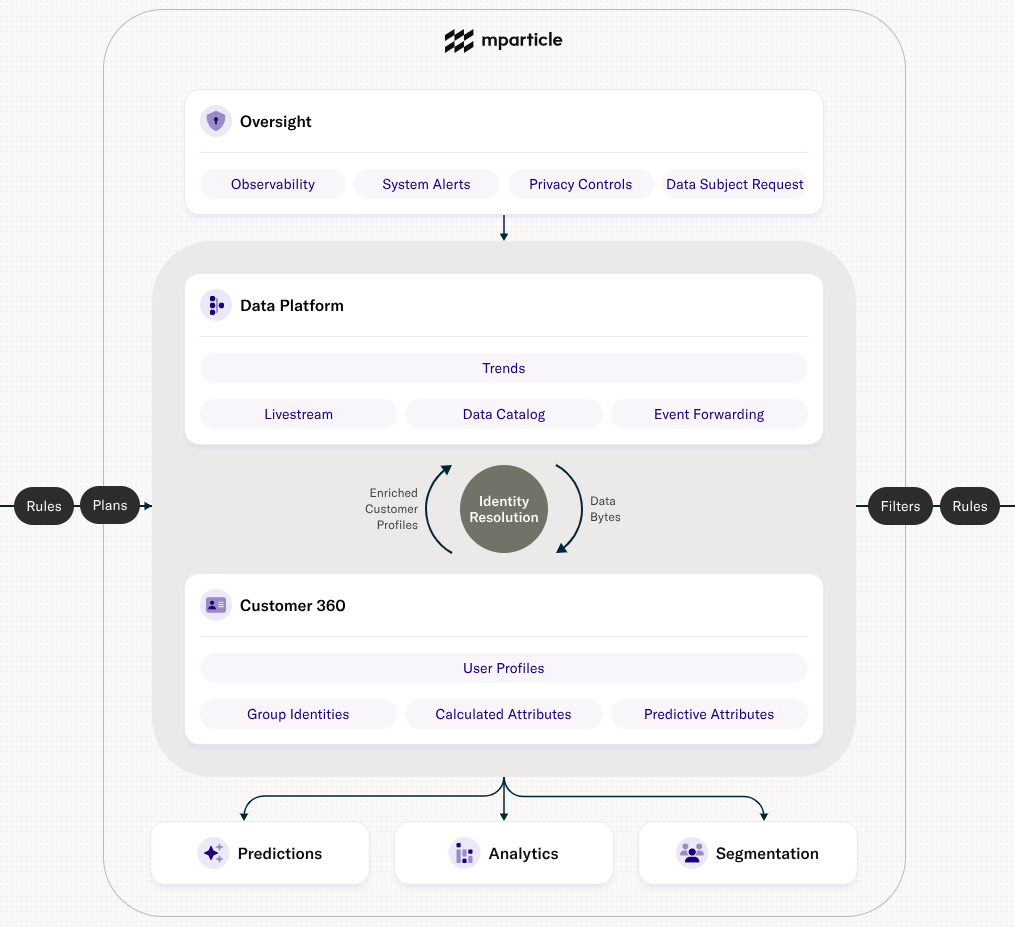
Oversight
This group of features allows you to monitor the health of your data infrastructure and manage your data privacy settings. Features here include:

Data Platform
The Data Platform features provide an overview of what data is flowing into mParticle, both in real time and historically. Features include:

Customer 360
Customer 360 is the collection of tools and features related to your customer data, including:

Predictions, Analytics, and Segmentation
From the Customer 360 Profile, you can gain a deeper understanding of your users’ behavior, and make predictions based on their behavior to power a highly personalized, omnichannel customer experience:
- Predictions: discover how best to engage with your users with mParticle’s machine learning and AI powered predictive analytics suite
- Analytics: gain actionable insights into how your users behave and interact with your brand
- Segmentation: create groups of related users and perform user journey analytics, testing, and cross-channel orchestration

Data platform management
mParticle provides several data management tools that help you control exactly what data you ingest from your inputs, what data you send to your outputs, and to improve the quality of your data. These tools are Data Plans, Rules, and Filters, and they’re shown on the Overview Map at the intersections between the mParticle Suites and your inputs and outputs.

Data Plans
Data Plans allow you to improve the quality of the data you ingest by validating inbound data against a schema. Data that doesn’t fit the schema you define isn’t ingested by mParticle, ensuring that you have high quality when creating Audiences, Predictions, or when forwarding data to your downstream marketing and engagement tools.
Data Plans only operate on data as it is ingested from inputs into the mParticle Suites.
To view your Data Plans, click the Plans button on the Overview Map.
Rules
Rules are scripts that manipulate data that is either being ingested from an input, or forwarded to an output. They allow you to cleanse, enrich, or transform your data by changing event names, modifying event or user attributes, or adding or removing events from a batch.
Rules can be used on both inbound and outbound data.
To view or add Rules, click the Rules button on the Overview Map.
Filters
Filters control the data that’s forwarded to your outputs. While Rules and Data Plans help you collect only the data you want, without duplicates or poor quality data points, Filters prevent all of your data from being forwarded to all of your outputs.
Filters can only be used on outbound data.
To view your filters, click the Filters button on the Overview Map.
Identity Resolution
IDSync, mParticle’s identity resolution framework, allows you to manage how your users are identified wherever, and whenever, they engage with your brand. IDSync works in tandem with Customer360 to give you control over exactly what data is attributed to which user profiles.
The Identity Resolution process is noted on the Overview Map between Data Platform and Customer360, but it is not currently navigable via the Overview Map.
To manage your IDSync settings click the Settings icon in the left nav bar, click Platform, and select the Identity Settings tab. Or, click on the identity resolution circle.
Was this page helpful?
- Last Updated: December 16, 2025